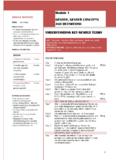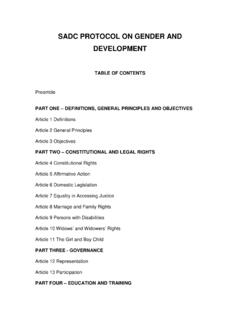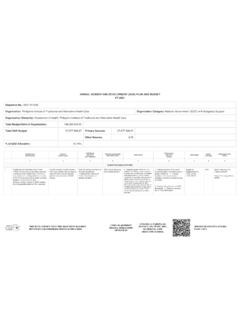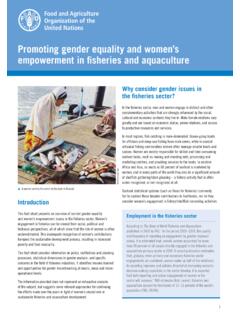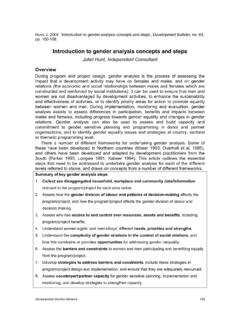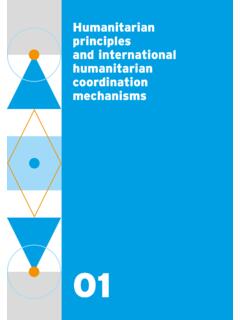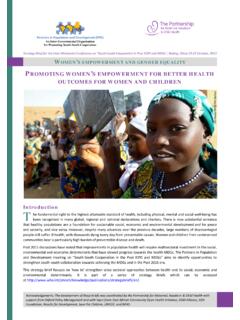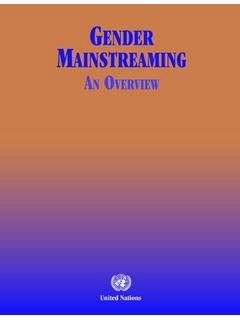Transcription of CONCEPT PAPER EDUCATION AND GENDER EQUALITY
1 1 CONCEPT PAPER : EDUCATION AND GENDER EQUALITYP hoto: Nicaragua, Christina GuldbrandsenOxfam is guided by Universal and Equitable access to Quality EDUCATION and also the fact that lack of access and poor quality of EDUCATION have serious consequences for especially girls and women (Oxfam Strategic Plan 2013-2019)..In November 2016, in Copenhagen, in a meeting convened by Oxfam IBIS, Oxfam constituted an EDUCATION Community of Practice and Influence agreeing that Strengthening transforma-tive public EDUCATION for all to fight inequality is the overall goal of our future EDUCATION work. Achieving this goal will: 1. Have a straight redistributive impact putting virtual income into the pocket of poor and marginalized people particularly in relation to girls and Enhance social Strengthen political mobilization - a transformative, quality EDUCATION leads to knowing your rights and responsibilities, having a voice, being able to participate and organize, and building active citizenship for children, youth and series of Oxfam IBIS CONCEPT papers define the Oxfam IBIS understanding and approach in key PAPER contains the following sections.
2 A) Justification for Oxfam IBIS work on the issueB) Brief overview of relevant theories and definitionsC) Presentation of Oxfam IBIS approach and lessons learnedD) References to further documentation CONCEPT PAPER EDUCATION AND GENDER EQUALITY2 CONCEPT PAPER : EDUCATION AND GENDER EQUALITYJUSTIFICATIONG ender inequality is a serious and pervasive form of discrimination affecting especially women and girls. Discrimination against women and girls is a major obstacle to obtaining their rights as citizens as well as to the development of societies. Non-discrimination and EQUALITY be-tween women and men are central principles of human rights law. The Universal Declaration of Human Rights adopted in 1948 proclaimed the equal entitlements of women and men to the rights contained in it, without distinction of any kind, such as sex.
3 The obligation of states to eliminate discrimination based on sex is also underlined in the International Covenant on Political and Civil Rights from 1966. The recently adopted Sustainable Development Goals (SDGs) to be reached by 2030 also promotes GENDER EQUALITY and women s empowerment. Goal number 5 pursues to Achieve GENDER EQUALITY and empower all women and girls, and is an opportunity to address structural obstacles and shift social norms. This would potentially enable permanent pathways out of poverty and inequality achieving the GENDER EQUALITY tar-gets of the 2030 agenda. GENDER EQUALITY is a right in itself, but it is also an important means to achieving other sustainable development goals. EDUCATION has the potential to play a crucial role in attaining GENDER EQUALITY , as documented for example by UNESCO in EDUCATION transforms lives (2013).
4 When a girl receives a quality EDUCATION , she is less likely to get pregnant young, be married early, be a victim of violence, get a job or contribute as active citizen to the development of society. Educating both girls and boys has a huge positive impact in terms of preventing GENDER inequality and GENDER based violence. Evidence shows, that the more literate the women in a country are, the lower female mortality rate and the better health and political integration of the launch of the EDUCATION for All (EFA) movement in 2000, GENDER EQUALITY in edu-cation has been considered necessary for social justice on a global scale. And yet, GENDER inequality is also pervasive in EDUCATION . Though significant progress has been made over the last decades in narrowing down GENDER disparities at primary and secondary level, in most parts of the world, girls and women are still disadvantaged in the EDUCATION systems.
5 Accord-ing to the Global EDUCATION Monitoring (GEM) report 2015, about 43 % of the world s out-of-school children will never go to school: 48% of girls compared with 37 % of boys are likely never to enter a classroom. Moreover, 500 million women above the age of 15 are illiterate, compared to 281 million men, meaning that 64% of the adult illiterate population are women. Fewer girls than boys get a secondary EDUCATION , and even fewer get a higher EDUCATION . It should be noted though, that in some countries, boys are now at a disadvantage, for exam-ple in some Latin American countries, girls are more likely to enrol in and complete their edu-cation than boys. Since 2000 there has been a growing concern over boys underachievement in learning outcomes. According to the GEM 2015 research from Brazil, Rwanda and other countries showed that men with less EDUCATION were more likely to be violent in the home and express discriminatory GENDER views.
6 However, only a few countries have put in place policies to address this concern. An EDUCATION that promotes GENDER EQUALITY needs to be of good qual-ity, explicitly aimed at addressing GENDER inequalities and transforming negative or rigid GENDER norms and stereotypes. The quality and transformative character of EDUCATION is crucial to en-sure that GENDER inequality is not reproduced in the formal EDUCATION system and in non-formal EDUCATION activities and later in life. Achieving GENDER justice is one of the goals in Oxfam s Strategic Plan 2013 2019. While the reasons behind inequality between women and men are about more than money there is CONCEPT PAPER : EDUCATION AND GENDER EQUALITY 3no doubt that economic inequality compounds GENDER inequality. In the case of children who have ever been to school, there is GENDER parity for middle income countries, but disparity at the expense of girls in low income countries where 93 girls for every 100 boys have ever been to school.
7 Oxfam works to encourage women s participation and transformative leadership; to eliminate violence against women and girls and to improve women s economic empowerment. Oxfam believes in transforming GENDER - and related power relations - as well as the struc-tures, norms and values that underpin them - by using EDUCATION . This transformation is critical to ending poverty and to empowering women to enable them to be global active citizens with rights equal to men. THEORIES AND DEFINITIONSGENDER GENDER refers to the socially constructed identities, attributes and roles between women and men, girls and boys, as well as the relations between women and those between men. These attributes, roles and relationships are context- and time-specific and changeable. GENDER influ-ences determines what is expected by, allowed for and valued in a women or a man in a given context.
8 In all societies there are differences and inequalities between women and men in re-sponsibilities assigned, activities undertaken, access to and control over resources, power and rights and decision-making opportunities. In most of the world s societies these socially con-structed differences and relations often results in a specific focus on girls and women because they are mostly adversely affected by existing GENDER inequalities and equalityGender EQUALITY refers to the equal rights, responsibilities and opportunities for women and men and girls and boys to access and control social, economic and political resources, includ-ing protection under the law. EQUALITY does not mean that women and men will become the same, but that there is EQUALITY of opportunity, that girls/women s and boys/men s rights, responsibilities and opportunities will not depend on whether they are born male or female.
9 GENDER EQUALITY is not a women s issue but should concern and fully engage men as well as justice Oxfam IBIS understands GENDER justice as the full EQUALITY and equity between women and men in all spheres of life, resulting in women jointly, and on an equal basis with men, defin-ing and shaping the policies, structures and decisions that affect their lives and society as a whole. This means that there is need both to continue improving legislation and policy, but also to transform societies through sustained, widespread changes in attitudes and beliefs about GENDER power relations. Oxfam IBIS envisions a safe and just world, where women and girls gain power over every aspect of their lives, including not to be exposed to violence. When women and girls are able to make their own choices and exercise their collective voice, and when institutions address their needs and interests, GENDER justice will be achieved.
10 GENDER mainstreaming Oxfam IBIS is involved in an ongoing process to ensure that all our work across development, humanitarian and campaigns programming incorporates the promotion of GENDER EQUALITY and women s rights. This process, known as GENDER mainstreaming (or integration), involves GENDER justice considerations being built into all stages of policy making and programming. 4 CONCEPT PAPER : EDUCATION AND GENDER EQUALITYThis includes using GENDER and power analysis, set focus on girls and women s rights objec-tives and specific actions explicit addressing structural GENDER discrimination - and not just its symptoms. As an organisation, we are committed to building the capacity of staff and partners to focus on GENDER justice and girls and women s rights and ensuring that GENDER is main-streamed in all our policies, structures, practices and beliefs.
